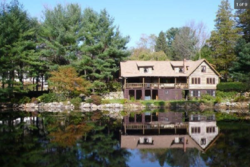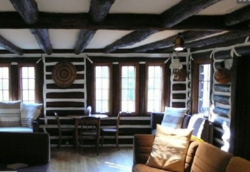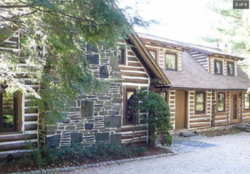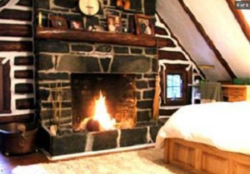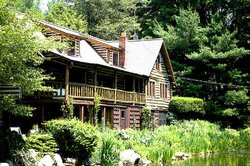I have R38 in the roof, R21 in the gables, and 10" logs. Still have to finish the outside gable siding, soffets, window and door trim so that should tighten things up a bit.Impressive indoor temps since it looks like the cabin is uninsulated.
Jotul 602 CB Install
- Thread starter Todd
- Start date
-
Active since 1995, Hearth.com is THE place on the internet for free information and advice about wood stoves, pellet stoves and other energy saving equipment.
We strive to provide opinions, articles, discussions and history related to Hearth Products and in a more general sense, energy issues.
We promote the EFFICIENT, RESPONSIBLE, CLEAN and SAFE use of all fuels, whether renewable or fossil.
You are using an out of date browser. It may not display this or other websites correctly.
You should upgrade or use an alternative browser.
You should upgrade or use an alternative browser.
SpaceBus
Minister of Fire
Nice! We are considering building a log cabin for my MIL and I wasn't sure how well they work in winter in the real world. I don't know anyone personally that lives in one in cold climates. We looked at a fairly nice 80's slab sided log cabin in NC and it stayed at 70df with no help (aside from shade trees) with the outside temp in the high 80's.I have R38 in the roof, R21 in the gables, and 10" logs. Still have to finish the outside gable siding, soffets, window and door trim so that should tighten things up a bit.
Ive heard some log homes you can heat with a candle and others leak like a sive. There are lots of different log home companies out there. I went with Yellowstone Log Homes. My logs have a Swedish cope between the logs and a strip of insulation which help create a better seal. No chinking but there is caulking inside and out.Nice! We are considering building a log cabin for my MIL and I wasn't sure how well they work in winter in the real world. I don't know anyone personally that lives in one in cold climates. We looked at a fairly nice 80's slab sided log cabin in NC and it stayed at 70df with no help (aside from shade trees) with the outside temp in the high 80's.
To continue the thread drift, long ago one of the professors at University of Maine had several "outhouses" built with different construction techniques including a couple of log cabins. They were not outhouses but looked like one as they were 4' by 4' interior space with a exterior door and that was it. There were a line voltage thermostat and an incandescent lightbulb to heat each one connected to a power meter. The "outhouses" where set up in an open field spaced so that they did not shade each other. They were left for a year and the power was recorded. Log Cabins did not do very well energy wise compared to standard framing. There was one variety of "log cabin" that did well which was log sided stick built structure. In Maine there was a regionally well known LC Andrews Custom Log Homes (now out of business) that was a log sided home, conventional stick built walls with milled vertical half round cedar log vertical siding. This was long before stress skin systems but expect the stress skins would have been the winner.
There are many claims made for energy efficiency of log cabins but they usually claim thermal mass benefits as they rarely win out on R value. The claim is the walls take a long time to heat up from the day and cool down at night. The problem is on most homes air infiltration is the biggest contributor to heating load and log homes have a lot of potential air infiltration points. Sure there are various milled logs with splines that are claimed to be latest and greatest but the vast majority of log cabins are made with unseasoned logs that are going to shrink, twist and crack. Standard details for most log cabins is to leave gaps above windows and door frames to account for inevitable shrinkage. I have seen a few interesting structural issues over the years where the building shrunk but various details did not take it into account. In most cases the owners lets the places cycle over several years and then have resilient chinking system installed.
Log cabins can definitely be things of beauty and I know a few folks who have built them from scratch and have great levels of pride in their builds but in cold climate they definitely are not the most energy efficient structure. They do usually tend to be smaller than many other structures as the dollars per square foot is high so that may give the illusion of energy efficiency. The reality for a hunting cabin or recreational cabin is much of the heat is line of sight radiation from a well placed wood stove.
There are many claims made for energy efficiency of log cabins but they usually claim thermal mass benefits as they rarely win out on R value. The claim is the walls take a long time to heat up from the day and cool down at night. The problem is on most homes air infiltration is the biggest contributor to heating load and log homes have a lot of potential air infiltration points. Sure there are various milled logs with splines that are claimed to be latest and greatest but the vast majority of log cabins are made with unseasoned logs that are going to shrink, twist and crack. Standard details for most log cabins is to leave gaps above windows and door frames to account for inevitable shrinkage. I have seen a few interesting structural issues over the years where the building shrunk but various details did not take it into account. In most cases the owners lets the places cycle over several years and then have resilient chinking system installed.
Log cabins can definitely be things of beauty and I know a few folks who have built them from scratch and have great levels of pride in their builds but in cold climate they definitely are not the most energy efficient structure. They do usually tend to be smaller than many other structures as the dollars per square foot is high so that may give the illusion of energy efficiency. The reality for a hunting cabin or recreational cabin is much of the heat is line of sight radiation from a well placed wood stove.
My wife grew up in this log home. The building is made entirely out of chestnut. It took a lot of heat to keep it comfortable, but it was a neat place. She grew up in it with no central heat and that was not fun in cold New England.
View attachment 254106 View attachment 254107 View attachment 254108 View attachment 254109 View attachment 254110
Its beauty for sure but definitely not designed for efficiency
 .
.SpaceBus
Minister of Fire
I'm a chronic thread detailer, but thank you for entertaining my questions nonetheless. I am trying to do better at staying on topic!
SpaceBus
Minister of Fire
Wow, that's a real work of art!My wife grew up in this log home. The building is made entirely out of chestnut. It took a lot of heat to keep it comfortable, but it was a neat place. She grew up in it with no central heat and that was not fun in cold New England.
View attachment 254106 View attachment 254107 View attachment 254108 View attachment 254109 View attachment 254110
Hopefully mine will be somewhat efficient. The logs were dead standing Lodgepole, nice and dry. They told me there should be little to no shrinkage and we didn't. Have to leave settling gaps for the windows and doors. I've been burning the cut offs and they burn very well.To continue the thread drift, long ago one of the professors at University of Maine had several "outhouses" built with different construction techniques including a couple of log cabins. They were not outhouses but looked like one as they were 4' by 4' interior space with a exterior door and that was it. There were a line voltage thermostat and an incandescent lightbulb to heat each one connected to a power meter. The "outhouses" where set up in an open field spaced so that they did not shade each other. They were left for a year and the power was recorded. Log Cabins did not do very well energy wise compared to standard framing. There was one variety of "log cabin" that did well which was log sided stick built structure. In Maine there was a regionally well known LC Andrews Custom Log Homes (now out of business) that was a log sided home, conventional stick built walls with milled vertical half round cedar log vertical siding. This was long before stress skin systems but expect the stress skins would have been the winner.
There are many claims made for energy efficiency of log cabins but they usually claim thermal mass benefits as they rarely win out on R value. The claim is the walls take a long time to heat up from the day and cool down at night. The problem is on most homes air infiltration is the biggest contributor to heating load and log homes have a lot of potential air infiltration points. Sure there are various milled logs with splines that are claimed to be latest and greatest but the vast majority of log cabins are made with unseasoned logs that are going to shrink, twist and crack. Standard details for most log cabins is to leave gaps above windows and door frames to account for inevitable shrinkage. I have seen a few interesting structural issues over the years where the building shrunk but various details did not take it into account. In most cases the owners lets the places cycle over several years and then have resilient chinking system installed.
Log cabins can definitely be things of beauty and I know a few folks who have built them from scratch and have great levels of pride in their builds but in cold climate they definitely are not the most energy efficient structure. They do usually tend to be smaller than many other structures as the dollars per square foot is high so that may give the illusion of energy efficiency. The reality for a hunting cabin or recreational cabin is much of the heat is line of sight radiation from a well placed wood stove.
SpaceBus
Minister of Fire
Will it ever truly settle? This is something I hadn't considered.Hopefully mine will be somewhat efficient. The logs were dead standing Lodgepole, nice and dry. They told me there should be little to no shrinkage and we didn't. Have to leave settling gaps for the windows and doors. I've been burning the cut offs and they burn very well.
Nope. It was mostly a 3 season inn that became a house. I installed the furnace system after it was sold. It was so big that we did some of the ductwork from inside the plenum. I had to use a chainsaw in a few places to create duct runs.Its beauty for sure but definitely not designed for efficiency.
Played around with my IR therm today. The hottest part of the stove is the cooking plate, I saw 900° with a full load at mid air setting! The front right above the door was also a hot spot where I had 800°. Between the cooking plate and top flue collar plate I hit 700°+. Internal flue temps were also in the 700° range. This was the hottest I've burned so far and I dont think I will go there again. 1/4 air gives me a nice 600ish stove and flue temp and warmed the cabin up nicely. It seems the flue temps somewhat coincided with the stove top temp once the burn settled in.
Built by Sherman Chase during the depression from dead chestnut during the blight. He built a couple others too.Wow, that's a real work of art!
SpaceBus
Minister of Fire
Chestnut is an unusual choice and I was curious as to why that was the pick for timber. Makes sense if they were all dead anyway. After reading a bit more about log cabins after this thread and I am warming up to them.Built by Sherman Chase during the depression from dead chestnut during the blight. He built a couple others too.
If the logs are 14" minimum diameter the whole structure should be at least R19 for the walls with softwoods at R1.4/inch. With modern techniques like threaded rods in each corner, sweedish cope, full length V notches with weather stripping, and a good chinking/caulking I don't see why a log home couldn't be a good alternative to a stick built home. It seems the real challenge is getting the gable ends and window/door openings air sealed. Maybe I'm missing something but modern technology seems to have made a big impact in log construction energy efficiency. Also, I'm no expert having only read some free online materials and watched several videos of folks building cabins in Europe.
That's about where I end up usually. That's with my air all the way/almost cut off. It'll stay that hot for 30 minutes or so then settle at 800 or so at the cooktop. I'm going to check my flue temps again next go roundPlayed around with my IR therm today. The hottest part of the stove is the cooking plate, I saw 900° with a full load at mid air setting! The front right above the door was also a hot spot where I had 800°. Between the cooking plate and top flue collar plate I hit 700°+. Internal flue temps were also in the 700° range. This was the hottest I've burned so far and I dont think I will go there again. 1/4 air gives me a nice 600ish stove and flue temp and warmed the cabin up nicely. It seems the flue temps somewhat coincided with the stove top temp once the burn settled in.
SpaceBus
Minister of Fire
Sounds like the air needs to be cut sooner. On a small, but active, load of coals my Morso will take off very quick. Yesterday the flue surface thermo shot up to 350 from 150 in just a few minutes. I cut the air down to ~%15 from wide open and the surface thermo settled at 225-250 on a full load.
Its been awhile since I've burned a non cat, may take a little getting use to again. Do you guys mostly try and burn full loads or do you find a couple sticks every few hours a better option?
kennyp2339
Minister of Fire
SpaceBus
Minister of Fire
I prefer full loads, easier to get the stove up to temp, etc. Sometimes I just don't need full heat and my small stove doesn't like to run easy on less than 1/3 load. Usually I'm just burning one or two splits with a bunch of kindling. Like an hour or so of active flames.
Its been awhile since I've burned a non cat, may take a little getting use to again. Do you guys mostly try and burn full loads or do you find a couple sticks every few hours a better option?
IMHO, based on my experience with the older 602's they were best run by matching the fuel input to the heating demand. This meant sometimes that if the heating demand was too low, the fire would be left to burn out and be restarted later. I think many folks just threw in slow burning split to avoid the relight cycle. Even though the active fire would be out, the ash layer in the bottom would hold coals and the residual heat in the chimney meant a good draft and fast relight. The worst operation was cram it full of wood and then crank the air inlet down to get a long burn. I expect the emissions upgrade probably has hidden air ports of some other method of preventing the air from being cranked down too low which leads to incomplete combustion. The trade off with this is the turndown of the stove is lower so its harder to get it to "idle" once the space is heated up.
SpaceBus
Minister of Fire
This is how I run my Morso. Low load =a few splits and let it go out (close the air on the coals to get them to last longer) . High load = crammed full and keep it goingIMHO, based on my experience with the older 602's they were best run by matching the fuel input to the heating demand. This meant sometimes that if the heating demand was too low, the fire would be left to burn out and be restarted later. I think many folks just threw in slow burning split to avoid the relight cycle. Even though the active fire would be out, the ash layer in the bottom would hold coals and the residual heat in the chimney meant a good draft and fast relight. The worst operation was cram it full of wood and then crank the air inlet down to get a long burn. I expect the emissions upgrade probably has hidden air ports of some other method of preventing the air from being cranked down too low which leads to incomplete combustion. The trade off with this is the turndown of the stove is lower so its harder to get it to "idle" once the space is heated up.
Last edited:
Yes, big contrast. Built starting in 1981. Owner build, it took a few years to finish, but they moved in after year 1.5.@begreen - that's one end of the spectrum, but the other end is your sister's place right? 1970's cons super insulated with the central masonry heater?
The EPA units burn completely differently then the old 602's. And yes, in addition to the primary air (which you can't shut down completely), there is a secondary air inlet on the rear that's non-adjustable.I expect the emissions upgrade probably has hidden air ports of some other method of preventing the air from being cranked down too low which leads to incomplete combustion.
I'm finding if I give the stove full air on reload my stove will take off too quick and just waste heat up the flue. My internal pipe temps can jump up to 700-800 in 10-15 min and then I end up fiddling around too much with the air setting to find that sweet spot.Sounds like the air needs to be cut sooner. On a small, but active, load of coals my Morso will take off very quick. Yesterday the flue surface thermo shot up to 350 from 150 in just a few minutes. I cut the air down to ~%15 from wide open and the surface thermo settled at 225-250 on a full load.
If I reload with 1/2 or even 1/4 air the flue temps will climb a little slower and keep more heat in the stove. In about 20-30 min the wood is good and charred and I can simply shut the air down completely giving me nice rolling secondaries and a more even heat output with 600ish stove temps.
Similar threads
- Replies
- 0
- Views
- 235
- Replies
- 11
- Views
- 572


